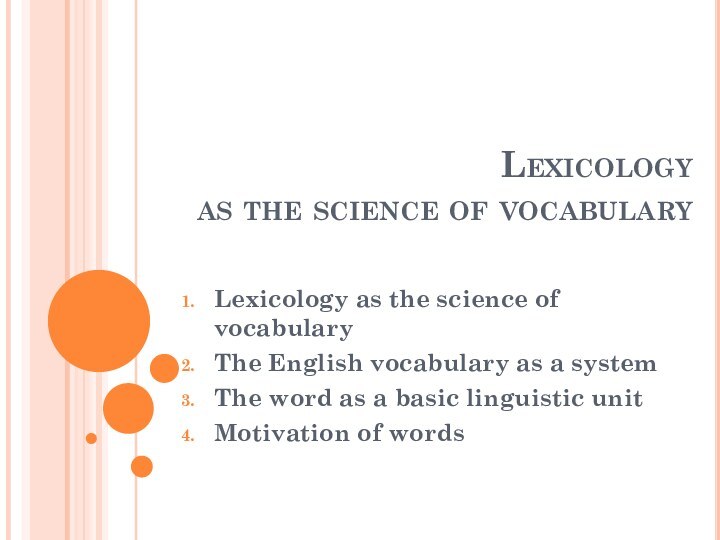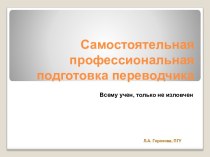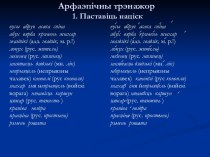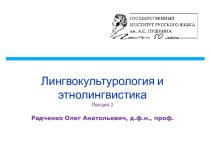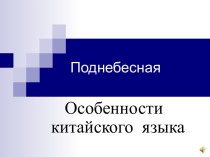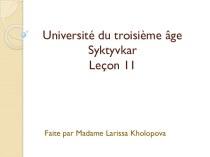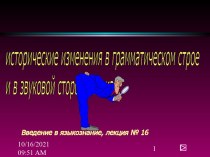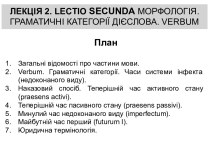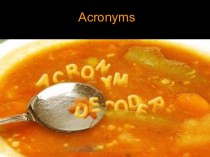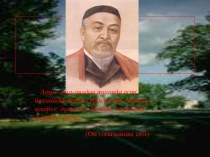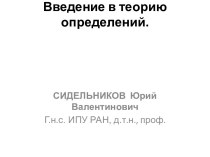Слайд 2
1. Lexicology as a branch of linguistics
Lexicology is
a branch of linguistics, the science of language.
The
term Lexicology is composed of two Greek morphemes:
lexis means ‘word, phrase’ (hence lexicos ‘having to do with words’) and
logos which denotes ‘learning, a department of knowledge’.
Thus, the literal meaning of the term Lexiсolоgу is ‘the science of the word’.
Слайд 3
Lexicology is a part of general linguistics dealing
with the vocabulary of a language.
Lexicology studies and
describes the vocabulary as to its origin, development and current use.
The term vocabulary denotes the system formed by the sum total of all the words and word phrases that a language possesses.
Слайд 4
There are several parts in lexicology which deal
with different aspects of words:
lexicology
Etymology studies the origin of
words.
Semasiology (semantics) investigates the word meaning.
Grammar studies grammatical relations between words and the patterns after which words are combined into word-groups and sentences.
Word-building studies the structure of words
Phonetics is concerned with the study of the outer sound form of the word.
Lexicography is the theory and practice of making dictionaries
Linguo-Stylistics studies the nature, functions and structure of stylistic devices and the effect it produces.
Слайд 5
Paralinguistics — the study of non-verbal means of
communication (gestures, facial expressions, eye-contact, etc.)
Pragmalinguistics — the branch
of linguistics concerned with the relation of speech and its users and the influence of speech upon listeners.
Слайд 6
Distinction is naturally made between General Lexicology and
Special Lexicology
General Lexicology is part of General Linguistics;
it
is concerned with the study of vocabulary irrespective of the specific features of any particular language.
Special Lexicology is the Lexicology of a particular language (e.g. English, Russian, etc.), i.e. the study and description of its vocabulary and vocabulary units, primarily words as the main units of language.
Слайд 7
There are two principal approaches in lexicology to
the study of language material:
the synchronic (Gr. syn
— ‘together, with’ and chronos — ‘time’)
The synchronic approach is concerned with the vocabulary of a language as it exists at a given time, for instance, at the present time. It is descriptive.
diachronic (Gr. dia — ‘through’) approach
The diachronic (historical) approach deals with the changes and the development of vocabulary in the course of time, with the evolution of words, how they originate, change their meaning and usage.
Ex. To tell one’s money – считать деньги
(OE tellian – считать)
Слайд 8
2. The English vocabulary as a system
Vocabulary
is the system formed by all the words and
word equivalents that the language has.
The term system is not merely the sum total of English words, it denotes a set of elements associated and functioning together according to certain laws.
It is a coherent homogeneous whole, constituted by interdependent elements of the same order related in certain specific ways.
Слайд 9
There are two fundamental types of relations:
syntagmatic
and paradigmatic.
Syntagmatic relationships are linear. A word is
studied in relationships with other neighbouring lexical units in connected speech.
Ex. The structure of a word: teach-er-s
Collocability (combinability) a white rose (colour) – white coffee (with milk) – white lie (harmless) – white meat (poultry).
Слайд 10
paradigmatic relations are contrastive. Paradigm < Lat paradigtna
< Gr paradeigma ‘model’ ‘to compare'.
They occur in
the words of similar meaning but of different functional properties. The words form an opposition. A lexical opposition is defined as a semantically relevant relationship of partial difference between two partially similar words.
Labour – work; man – chap; doubt : : doubtful
The main problems of paradigmatics are polysemy, synonymy, antonomy, functional styles.
Слайд 11
In the vocabulary one can find the following
oppositions:
native words – borrowed (corn, milk – pizza, pasta)
formal
– informal (begin – commence; abandon – give up)
emotionally coloured – emotionally neutral (daddy – father)
common words – terms (metaphor)
obsolete (words that are not used any longer), archaisms (words that once were common but now are replaced by synonyms) – neologisms (new words) – eve, morn – laptop (ноутбук), to network, filmnik.
Слайд 12
The English vocabulary is different from the vocabularies
of other languages in the following features:
monomorphemic structure of
most important words (man, go)
widespread development of homonymy (sent – scent – cent, lead – lead)
widespread polysemy (a word has several meanings)
way – track, road; direction;
progress (to push one’s way);
a course of actions (I like it this way);
manner, behavior (I don’t like his way);
respect or degree (the photos are in all way similar). http://www.visualthesaurus.com/app/view
4. very limited antonomy of English words (fire can be a noun and a verb).
Слайд 13
3. The word as a basic linguistic unit
UNIT
is one of the elements into which a whole
may be divided or analysed and which possesses the basic properties of this whole.
Lexical units are two-facet elements possessing form and meaning.
apartment – a furnished dwelling
The basic lexical units are the word, the morpheme, the phoneme and set expressions.
The borderline between various linguistic units is not always sharp and clear.
Слайд 14
Morphemes
are parts of words, into which they may
be analysed.
They function in speech only as constituent
parts of words.
They cannot be divided into smaller meaningful units.
The meaning of morphemes is more abstract and more general than that of words and at the same time they are less autonomous.
use – ful broad – en
use – less re – cycle – ing
use – ful – ness seven – teen – th
Слайд 15
Words
are the central elements of language system.
The
word is a complex phenomenon, because it is a
phonological, semantic and grammatical unit at the same time.
The word can consist of only one morpheme (ex. I).
It can be equal to one morpheme (boy, go).
It can be an equivalent of a phrase (red tape – бюрократия).
The word can comprise a sentence (Silence!).
Words are indivisible and fulfil the nominative, significative, communicative and pragmatic functions.
Слайд 16
The word has many different aspects.
1) It
has a sound form because it is a certain
arrangement of phonemes;
2) it has its morphological structure, being also a certain arrangement of morphemes;
3) when used in actual speech, it may occur in different word forms, different syntactic functions and signal various meanings.
4) In the spelling system of the language words are the smallest units of written discourse: they are marked off by solid spelling.
Слайд 17
The word is the smallest meaningful language unit
capable of functioning alone and characterised by morphological indivisibility,
semantic integrity and positional mobility within a sentence.
The weak point of that definition is that it does not establish the relationship between language and thought.
the word is a dialectical unity of form and content, of the outer side and inner side. The outer side is the sound and graphical form. The inner side is the meaning rendering the emotion or the concept in the mind of the speaker which he intends to convey to his listener.
Слайд 18
The triangle of reference
It is also known
as the triangle of meaning and the semiotic triangle.
It is a model of how linguistic symbols are related to the objects they represent. The triangle was published in The Meaning of Meaning (1923) by Ogden and Richards.
Слайд 19
4. Motivation of words
The term motivation is used
to denote the relationship existing between the phonemic or
morphemic composition and structural pattern of the word on the one hand, and its meaning on the other.
Motivation is the way in which a given meaning is represented in the word.
There are three main types of motivation:
phonetical motivation
morphological motivation
semantic motivation
Слайд 20
The motivation is phonetical
when there is a
similarity between the sounds that make up the word
and those referred to by the sense. This phenomenon is called onomatopoeia.
Ex.: bang, buzz, cuckoo, giggle, gurgle, hiss, purr, whistle.
Here the sounds of a word are imitative of sounds in nature because what is referred to is a sound or at least, produces a characteristic sound (cuckoo).
There’s the variability of echo-words within one language and between different languages. Gf. cuckoo (Engl), Kuckuck (Germ), кукушка (Russ).
also: purr (of a cat), moo (of a cow), crow (of a cock), bark (of a dog), neigh (of a horse) and their Russian equivalents.
Слайд 21
Some linguists consider one more type of motivation
closely akin to the imitative forms, namely sound symbolism.
Some words are supposed to illustrate the meaning more immediately than do ordinary words.
Ex.: flap, flip, flop, flitter, flicker, flutter, flash, flush, flare;
glare, glitter, glow, gloat, glimmer;
sleet, slime, slush,
where fl- is associated with quick movement,
gl- with light and fire,
sl- with mud.
Thus, phonetically such words may be considered motivated.
Слайд 22
morphological motivation
Its main criterion is the relationship between
morphemes.
Hence all one-morpheme words, e.g. sing, tell, eat,
are by definition are non-motivated. It is observed in derived words built by affixation, conversion and compounding.
Thus, the prefix ex- means ‘former’ when added to human nouns: ex-filmstar, ex-president, ex-wife. vitaminise, re-think, finger-ring, ring-finger
Слайд 23
semantic motivation
It is based on the co-existence of
direct and figurative meanings of the same word within
the same synchronous system.
Ex.: Mouth as a part of the human face,
and any opening or outlet
(used metaphorically): the mouth of a river,
of a cave, of a furnace.
Jacket is a short coat and also a protective cover for a book, a phonograph record or an electric wire.
Слайд 24
Some words seem unmotivated (go, face, boy).
The
word is said to be non-motivated for the present
stage of language development when the connection between the meaning of the word and its form is conventional that is there is no reason for the word having this particular phonemic and morphemic composition. They have lost their motivation. It can be restored in diachronic researches.
the history of not which is a reduced form of nought from OE nowiht
